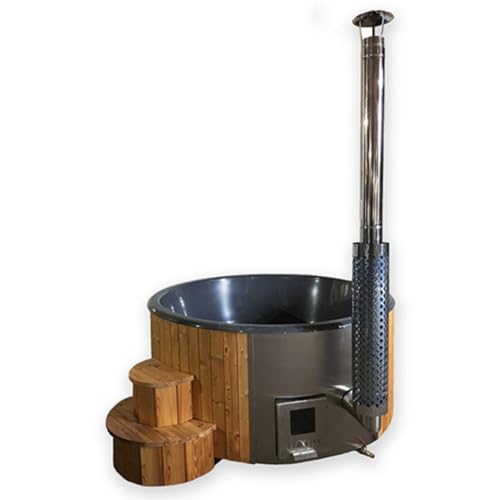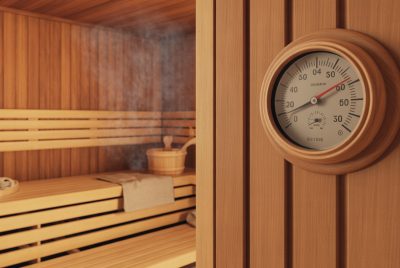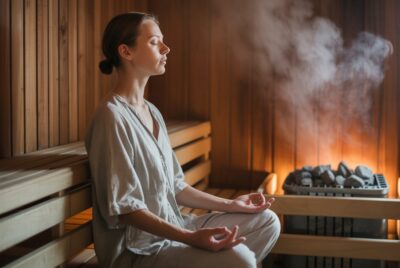Wood Fired Hot Tub: The Ultimate Backyard Relaxation Experience
*We may earn a commission for purchases made using our links. Please see our disclosure to learn more.
Picture this: steam rising from crystal-clear water under a canopy of stars, the gentle crackle of burning wood providing both warmth and ambiance. This isn’t just a dream—it’s the reality that awaits with a wood fired hot tub. These remarkable installations transform any backyard into a personal spa retreat, combining the primal satisfaction of wood-burning heat with the luxurious comfort of hot water therapy.
Unlike their electric or gas-powered counterparts, wood fired hot tubs offer something special—a connection to nature, sustainability, and the ancient human relationship with fire. They represent more than just a way to heat water; they embody a lifestyle choice that prioritizes simplicity, environmental consciousness, and authentic relaxation experiences.
“A wood fired hot tub isn’t just about the destination of warm water—it’s about the journey of building the fire, tending the flames, and connecting with the elemental process of heating water naturally.”
– Outdoor Living Magazine
Key Takeaways
- Eco-Friendly Heating: Wood fired hot tubs use renewable fuel sources and produce zero electric consumption
- Cost-Effective Operation: Significantly lower ongoing costs compared to electric or gas heating systems
- Off-Grid Capability: Perfect for remote locations without electrical infrastructure
- Authentic Experience: Provides a more engaging, hands-on approach to relaxation
- Year-Round Use: Effective heating even in cold climates when properly maintained
- Customizable Heat: Direct control over water temperature through fire management
Recommended Wood Fired Hot Tub Products
1. Northern Lights Group Japanese Wood Fired Heater
Immerse yourself in timeless luxury with the Japanese Wood Ofuro Soaking Tub by Northern Lights Group. Crafted from premium Grade "A" Clear Western Red Cedar, this beautifully designed tub measures 35” in diameter, 30” in height, and 68” in length, comfortably seating two. The included Stainless TimberLine Campfire Wood Fired Hot Tub heater, manufactured in Canada, offers a natural, efficient heating solution without the need for electricity. Backed by a 3-year limited warranty, this wood-fired tub is perfect for creating an authentic, tranquil spa experience in your own backyard.
This premium Japanese Ofuro tub features a separate stainless wood-fired heater for quick, natural heating and safety. Crafted from Grade “A” Clear Western Red Cedar, it offers superior insulation, weather resistance, and a timeless aesthetic perfect for outdoor relaxation.
- Authentic Design: Handcrafted from top-grade Western Red Cedar for a traditional, luxurious soaking experience.
- Efficient Heating: Features a stainless wood-fired heater for quick and eco-friendly water heating.
- Compact Size: Ideal for two people, perfect for intimate or solo relaxation.
- High Price: Premium craftsmanship and imported components contribute to a higher cost.
- Manual Heating: Requires time and effort to light and maintain the wood fire.
- Limited Space: Compact size may not accommodate taller individuals comfortably.
2. Aleko Wood Hot Tub and Ice Bath with Internal Stove
Relax and rejuvenate with the Aleko Wood Hot Tub and Ice Bath, designed for both hot soaking and cold plunge therapy. Crafted from durable pine with a corrosion-resistant stainless steel internal stove, this tub heats efficiently without electricity or gas, offering a true off-grid experience. Its circular design and 422-gallon capacity make it perfect for 4-5 people. Included accessories like an insulated cover, wooden paddle, and steps enhance convenience and safety.
A complete DIY wood-fired hot tub kit that includes everything you need for setup. Features a stainless steel internal stove for efficient heating and comes with step-by-step instructions for the hands-on homeowner.
- Versatile Use: Functions as both a wood-fired hot tub and a cold plunge for year-round wellness.
- Eco-Friendly: Off-grid heating with no need for electricity or pumps.
- Efficient Design: Internal stove heats faster and offers better safety than external models.
- Manual Operation: Requires time and effort to maintain the wood fire and stir water.
- Large Size: Requires a spacious backyard and heavy setup.
- Maintenance Required: Needs regular cleaning to prevent debris and algae buildup.
3. Canadian Redwood Cedar 5′ Outdoor Wood-Fired Hot Tub
Enjoy the luxurious warmth and natural beauty of the Canadian Redwood Cedar Outdoor Hot Tub. This premium wood-fired tub features a 5-foot diameter and is crafted from rich, natural redwood cedar, offering excellent insulation and weather resistance. Designed for those who value relaxation and craftsmanship, it includes a paddle for stirring water and ensures a traditional spa-like experience with minimal electricity use.
Crafted from natural Canadian redwood cedar with built-in seating and a durable wood-fired heater. Includes paddle, easy-to-assemble design, and all necessary hardware.
- Premium Materials: Made from natural redwood cedar for superior durability and natural insulation.
- Off-Grid Use: Wood-fired heating means no electricity or gas is required.
- Spacious Design: 5-foot diameter offers plenty of room for relaxing and soaking.
- Heavy Weight: Weighing 550 pounds, it requires a sturdy foundation and setup assistance.
- Manual Heating: Requires time and effort to heat water using a wood stove.
- Assembly Required: Some DIY assembly needed, though it comes with a paddle and simple tools.
4. SaunaLife Model S4N Wood-Fired Hot Tub
Immerse yourself in pure relaxation with the SaunaLife Model S4N Wood-Fired Hot Tub. Crafted from durable Thermo-Spruce and reinforced with a contoured fiberglass interior, this tub offers luxury and efficiency. The dual-compartment stainless steel heater rapidly warms up the water in under two hours, providing an off-grid, eco-friendly soak for up to six bathers. Designed for convenience, it arrives fully assembled with an insulated cover, drainage system, and easy-access steps.
Elegant Scandinavian design with exceptional thermal retention. Features a robust external wood-fired heater and an optional LED lighting system for a serene evening ambiance.
- Rapid Heat-Up: Dual-compartment wood-fired heater warms water in under two hours.
- Fully Assembled: Arrives ready to use with insulated cover, steps, and drainage system.
- Spacious Comfort: Designed to comfortably accommodate up to six people.
- Heavy Shipping: Requires LTL freight shipping due to size and weight.
- Manual Heating: Needs wood and effort to maintain water temperature.
- High Price Point: Premium quality comes with a higher investment.
The Journey into Wood Fired Hot Tub Ownership
Discovering the Appeal
The path to wood fired hot tub ownership often begins with a desire to disconnect from the digital world and reconnect with simpler pleasures. Many discover these rustic spas during visits to mountain cabins, wellness retreats, or through friends who’ve embraced the off-grid lifestyle.
The appeal extends beyond mere functionality. Wood fired hot tubs represent a rebellion against the instant-gratification culture that dominates modern life. They require patience, planning, and active participation—qualities that many find therapeutic in themselves.
Understanding the Transformation Process
The Physical Transformation
A backyard equipped with a wood fired hot tub undergoes a remarkable metamorphosis. The installation becomes a focal point that draws people outdoors, encouraging more time spent in fresh air and natural surroundings. Gardens often evolve around these installations, with pathways, outdoor seating areas, and complementary landscaping emerging organically.
The Lifestyle Shift
Owners frequently report significant changes in their daily routines and social interactions. Evening entertainment shifts from indoor activities to outdoor gatherings centered around the warming ritual of the hot tub. The process of building and maintaining the fire becomes a meditative practice that many describe as surprisingly therapeutic.
The Social Dynamic
Wood fired hot tubs naturally become community gathering spaces. The shared experience of tending the fire, monitoring water temperature, and enjoying the fruits of collective labor creates bonds that differ markedly from simply turning on an electric spa.
Key Heating Methods and Techniques
External Wood Heater Systems
External heaters represent the most popular choice for wood fired hot tubs. These systems circulate water through a separate heating chamber, allowing for safer operation and easier maintenance. The heater typically sits adjacent to the tub, connected by insulated pipes that maintain water circulation.
Advantages:
- Enhanced safety with fire separated from bathing area
- Easier maintenance and cleaning
- More efficient heat transfer
- Reduced risk of damage to tub materials
Installation Considerations: The external heater requires proper positioning to ensure optimal circulation while maintaining safe distances from the tub and surrounding structures. Professional installation often proves worthwhile to ensure proper connection and safety compliance.
Internal Heating Elements
Some wood fired hot tubs feature internal heating chambers built directly into the tub structure. These systems provide rapid heating and maintain heat efficiently due to direct water contact with the heating element.
Benefits:
- Faster heating times
- More compact installation footprint
- Direct heat transfer efficiency
- Lower initial equipment costs
Challenges:
- Requires careful water level management
- More complex cleaning procedures
- Potential safety considerations during use
Hybrid Heating Approaches
Modern wood fired hot tubs increasingly incorporate hybrid systems that combine wood burning with backup electric or gas heating. These systems provide flexibility for different usage patterns and weather conditions.
Overcoming Common Challenges
Temperature Regulation Difficulties
New owners frequently struggle with achieving and maintaining optimal water temperatures. Unlike electric systems with precise digital controls, wood fired heating requires developing an intuitive understanding of fire management, wood selection, and heat retention principles.
Solutions:
- Invest in a quality water thermometer for accurate monitoring
- Learn to read fire behavior and adjust fuel accordingly
- Understand the relationship between outside temperature and heating requirements
- Develop a routine for consistent results
Maintenance and Cleaning Concerns
The combination of wood ash, outdoor exposure, and regular water changes creates unique maintenance challenges that differ significantly from conventional hot tubs.
Effective Approaches:
- Establish regular cleaning schedules for both tub and heater components
- Use appropriate wood types that produce minimal ash
- Install proper drainage systems for easy water changes
- Invest in quality covers to protect from debris and weather
Weather Dependency Issues
Outdoor wood fired systems face challenges during inclement weather, from difficulty lighting fires in wet conditions to heat loss during windy periods.
Practical Solutions:
- Create windbreaks around the heater area
- Maintain dry firewood storage accessible in all weather
- Learn fire-starting techniques for various conditions
- Consider seasonal operational adjustments
Social Coordination Challenges
Unlike instant-heat electric spas, wood fired hot tubs require advance planning and coordination, which can complicate spontaneous use or social gatherings.
Management Strategies:
- Develop realistic timeframes for heating from cold
- Create scheduling systems for regular use
- Educate family and friends about preparation requirements
- Establish backup plans for failed heating attempts
Essential Operational Guidelines
Wood Selection and Preparation
The choice of firewood significantly impacts heating efficiency, maintenance requirements, and overall user experience. Hardwoods like oak, maple, and birch provide sustained heat output with minimal ash production, while softwoods offer quick ignition but burn faster and create more residue.
Optimal Wood Characteristics:
- Moisture content below 20% for efficient burning
- Split to appropriate sizes for heater specifications
- Seasoned for at least six months for hardwoods
- Stored in dry, ventilated conditions
Fire Building Techniques
Successful wood fired hot tub operation depends heavily on proper fire building and maintenance skills. The goal extends beyond simply creating flames to establishing a consistent, controllable heat source that can be maintained over several hours.
Effective Fire Management:
- Build foundation fires with small kindling and gradually add larger pieces
- Maintain airflow for complete combustion
- Monitor and adjust fuel addition based on water temperature
- Learn to recognize optimal burning patterns for sustained heat
Water Management Protocols
Proper water management involves more than simply filling and draining the tub. Considerations include water quality, chemical balance, filtration needs, and seasonal adjustments.
Key Water Considerations:
- Regular testing and adjustment of pH levels
- Appropriate sanitization without over-reliance on chemicals
- Seasonal water change schedules based on usage patterns
- Integration of natural water treatment methods when possible
Environmental and Lifestyle Benefits
Sustainability Advantages
Wood fired hot tubs align with growing environmental consciousness by utilizing renewable fuel sources and eliminating dependence on fossil fuel-generated electricity. When sourced responsibly, firewood represents a carbon-neutral heating option that supports local economies and forest management practices.
Connection to Natural Rhythms
Operating a wood fired hot tub creates a deeper connection to natural cycles and seasonal patterns. Users become more aware of weather conditions, daylight patterns, and the subtle changes that mark seasonal transitions.
Physical and Mental Health Benefits
Beyond the obvious physical benefits of hot water therapy, wood fired hot tubs provide unique mental health advantages. The ritual of fire building, the satisfaction of self-sufficiency, and the complete disconnection from digital distractions create powerful stress relief opportunities.
Community Building Opportunities
These installations naturally foster community connections. Neighbors often become curious about the setup, leading to conversations and shared experiences. The collaborative nature of operation—from wood splitting to fire tending—creates opportunities for meaningful social interaction.
Advanced Techniques and Modifications
Efficiency Improvements
Experienced users develop various techniques to improve heating efficiency and reduce fuel consumption. These include strategic placement of heat reflectors, wind management systems, and thermal mass additions that help retain heat longer.
Seasonal Adaptations
Different seasons require adjusted approaches to wood fired hot tub operation. Winter use demands additional considerations for preventing freezing, while summer operation focuses on quicker heating and shorter burn times.
Integration with Outdoor Living Spaces
Successful wood fired hot tub installations often evolve into comprehensive outdoor living areas. This might include outdoor kitchens, fire pits, pergolas, and landscaping that create cohesive entertainment spaces.
Future Aspirations and Continuous Learning
Skill Development Journey
Wood fired hot tub ownership represents an ongoing learning experience. Users continuously refine their techniques, discover new approaches, and develop increasingly sophisticated understanding of fire, water, and weather interactions.
System Upgrades and Modifications
Many owners eventually pursue upgrades or modifications to improve their systems. This might include more efficient heaters, automated circulation pumps, or aesthetic enhancements that better integrate with landscape design.
Community Engagement
Advanced users often become ambassadors for the wood fired hot tub lifestyle, sharing knowledge with newcomers and contributing to online communities dedicated to these unique installations.
Conclusion
Wood fired hot tubs represent more than just an alternative heating method—they embody a philosophy of intentional living that prioritizes sustainability, community, and connection to natural processes. While they require more active participation than conventional spas, this engagement becomes part of their appeal for many users.
The journey from initial curiosity to experienced operation involves challenges, learning opportunities, and profound satisfactions that extend far beyond simple relaxation. These installations transform not just backyards but lifestyles, creating opportunities for deeper connections with nature, community, and the simple pleasure of warm water under open sky.
For those considering this path, the key lies in embracing both the practical realities and the philosophical implications of choosing wood fire over electric convenience. The reward is an authentic, sustainable, and deeply satisfying approach to relaxation that connects us to both ancient traditions and modern environmental consciousness.
Whether used for solitary reflection or community gathering, wood fired hot tubs offer something increasingly rare in our digital age—an experience that demands presence, patience, and participation, delivering benefits that extend far beyond the physical comfort of warm water.
Frequently Asked Questions
How long does it take to heat a wood fired hot tub from cold?
Heating time varies significantly based on tub size, outside temperature, and heater efficiency, but typically ranges from 2-4 hours for a standard 6-person tub. Larger tubs or colder conditions may require 4-6 hours. Starting with warmer water can reduce heating time considerably.
What type of wood works best for heating hot tubs?
Hardwoods like oak, maple, ash, and birch provide the best combination of heat output and burn duration. Avoid softwoods like pine or cedar for primary heating, though they work well for kindling. Always use seasoned wood with moisture content below 20% for optimal efficiency.
Can wood fired hot tubs be used year-round in cold climates?
Yes, wood fired hot tubs actually perform better in cold weather due to improved heat transfer efficiency. However, winter use requires additional considerations like preventing pipe freezing, maintaining dry firewood storage, and allowing extra heating time for extremely cold conditions.
How much does it cost to operate a wood fired hot tub compared to electric?
Operating costs are significantly lower than electric hot tubs, typically 60-80% less expensive. A cord of seasoned hardwood ($200-400) can provide dozens of hot tub sessions, while electric heating might cost $50-100 monthly in ongoing electricity charges.
What maintenance is required for wood fired hot tub systems?
Regular maintenance includes cleaning ash from the heater after each use, inspecting and cleaning circulation pipes monthly, changing water every 2-4 weeks depending on usage, and annual inspection of all connections and seals. The heater may need professional servicing annually to ensure optimal performance and safety.
















